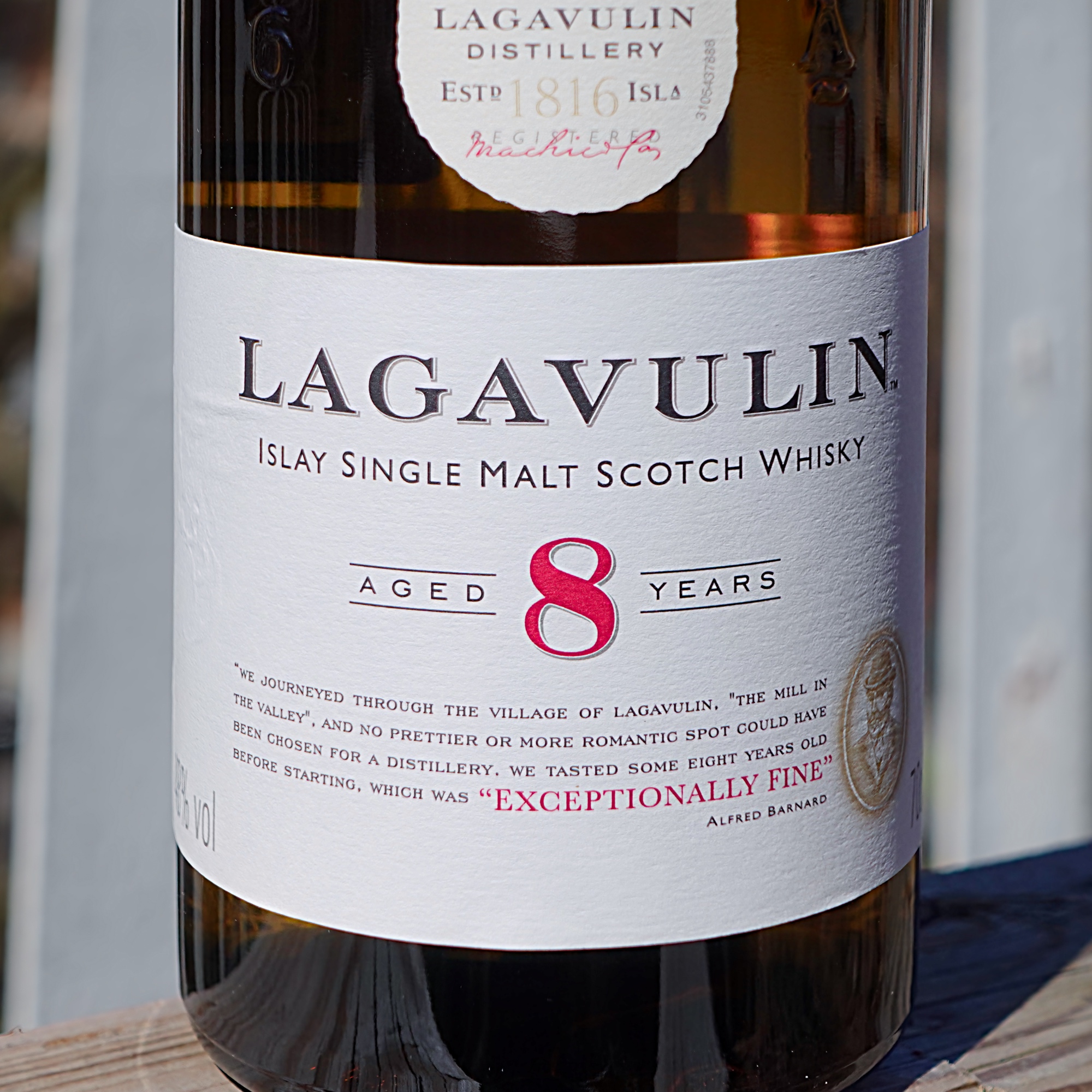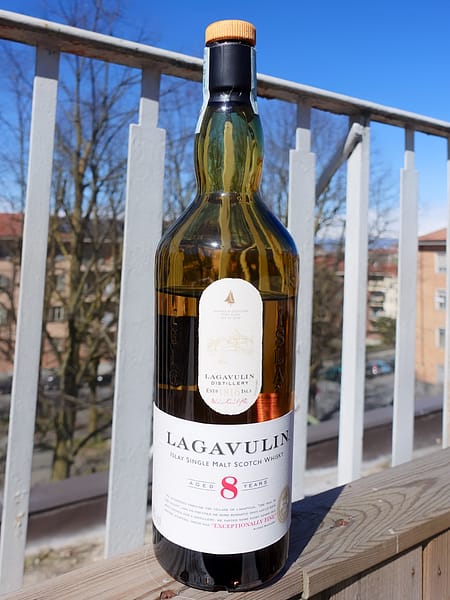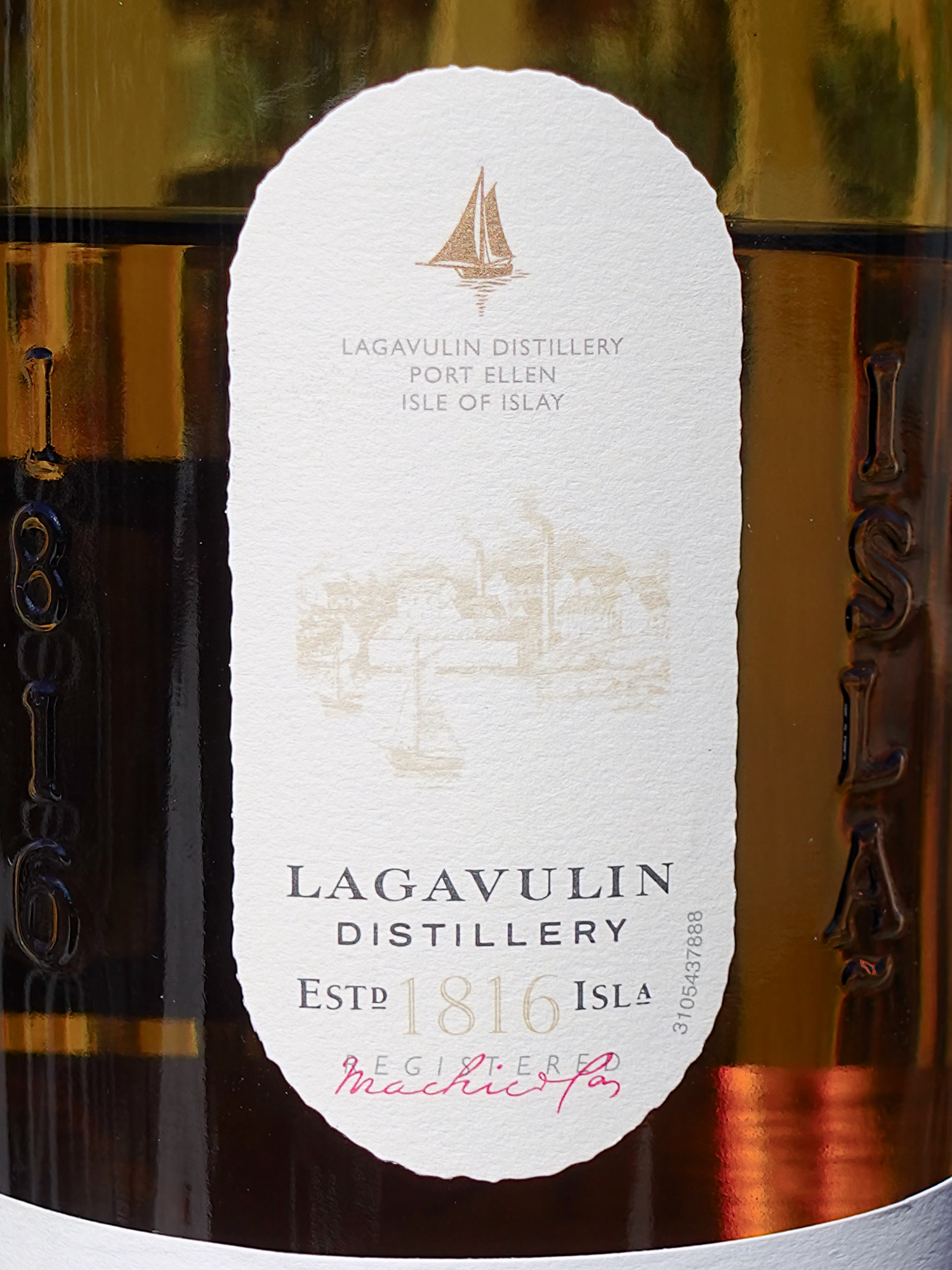Following the Wee beastie, I am looking at the Lagavulin 8-year-old for the second review dedicated to entry-level peated single malts. Talking about the Lagavulin 8, requires some words on the 16, the infamous price increase the latter has gone through and how Lagavulin’s Original Bottling lineup has shifted. It also provides an opportunity to reflect on Diageo’s price strategy and where it seems to be headed. Yet I am not writing this post to bash Diageo. The love Lagavulin 8 receives from the online whisky community made me curious to try this one out.

An old tradition revived?
The Lagavulin 8 was originally a special edition released on the market to celebrate Diage’s 200th anniversary in 2016. The original special edition, aged exclusively in refill American oak casks, became part of the standard lineup the following year in a slightly modified vatting (American and European casks). The label carries a quote from Alfred Barnard who, in his “The Whisky Distilleries of the United Kingdom”, published in the 1880s described an 8-year-old Lagavulin as ”exceptionally fine”. The historic connection to the 8-year-old of yore is a nice romantic idea. That’s all it is. Today’s 8-year-old is unlikely to have a strong resemblance to the 1880’s version.
Anniversary edition aside, it is safe to say that the launch of the 8 provided Diageo with an opportunity to shuffle the positioning of its standard lineup. If you are new to whisky or, like me, you were too busy during the pandemic to even consider whisky, I have added a summary of the Lagavuin 16 price kerfuffle at the end (you can jump to it here). This might help shed some light on some of the hate Diageo gets from many whisky fans. If you have started drinking whisky any time before 2022, you are fully aware of the story. What should we expect from Diageo regarding the 8-year-old?
Looking into the crystal ball
Rising prices are not unique to whisky, especially in the past 2 years. Whisky price increases though have gone way beyond what other goods have experienced. Considering what happened to the 16, will Lagavulin maintain an approachable price for its new entry-level original bottling? I am pessimistic. From what I see, the 8-year-old seems to be going the same way as the 16. In the 9 months since I bought my bottle, the price in the same large Italian supermarket chain I originally purchased it from, has increased by almost 12%, while inflation over the same period was only 0.7%.
Besides the UK, where this whisky is constantly on offer in one of the major supermarket chains, other countries in Europe seem to experience a similar trend. Diageo’s focus on the premiumisation of its portfolio continues to be a highlight as stated in their latest investor presentation. I suspect that this strategy, combined with the lack of transparency provided on their bottlings, will continue to sour us whisky aficionados towards Diageo.
And yet, the Lagavulin 8 has been collecting positive reviews and has carved a place as a solid Islay peated malt for many. So, while Diageo’s strategies might annoy us as consumers, it is the spirit in the bottle that matters most.

TL:DR: Difficult to both critique and love. It is technically sound. Some might find it a bit young, but for me, it is just a bit too polished.
Vote*: 6 A good whisky
Lagavulin 8 Years Old
Specs
Price paid: €52.47
Lot: L2038CM007
ABV: 48%
Natural colour: Not stated but unlikely
Non-chill filtered: Not stated but unlikely
Casks Used: No information is provided on the bottle or packaging. I did find some sources mentioning refill American and European casks.
Tasting Notes

Colour: Very pale straw. Although the cask information is vague, this is with litle doubt a mostly ex-bourbon matured whisky. If there is any caramel in this dram, it must be mere traces. Why not be done with caramel altogether considering how pale it is and give us that statement on the label?
Nose: The first impression is peaty and maritime, with mild medicinal Islay peat, band-aid and rubber bands, and a hit of sea spray. Quickly there is a layer of sweet and sour aromas. Vanilla syrup, dried lemon peel, lemon drops, pear and pineapple. Some white pepper & jalapeño spice betrays the age of the whisky.
After a while, I pick up a lingering floral note (dried rose maybe?). Then there is plastcine, almonds and a vinegary tang, which together with the maritime notes makes me think of salt and vinegar chips. Once the whisky has had a chance to rest in the glass (or once my peat blindness hits) it gets more fruity. Pineapple, peach, apple juice, even a little milk chocolate and toffee become more intense. I love the complexity, I just wish it would be a bit louder.
Taste: On the palate, it is noticeably young, hot, and spicy and yet the mouthfeel is quite creamy The imprint is similar to the nose, peaty, maritime, sour and sweet, but both more intense and less complex. I taste woodfire ash, some phenolic medicinal notes, lemon peel, vanilla syrup, sea salt, and malt. Some light fresh laundry and milk chocolate notes are there but in the background. If the nose had a level of complexity that intrigued me, the palate comes across as less refined and simple
Finish: Medium. Youthful at first, as on the plate, but then some cleaner and more complex notes come through. A strong malted barley note first then, smoke, sea salt, milk chocolate, pineapple, sour lemon candy, black tea and some lingering wood ash. The aftertaste is peaty, maritime and with some noticeable bitterness. I should love these notes yet everything, as on the nose, I am left thinking that even at 48% this comes across as a bit mild.
Vote: 6, A good whisky that ticks a lot of boxes (not the whisky geek ones maybe) but fails to ignite any spark for me. Even with its youthful edges, it is almost too polished. Fine at the price I paid, with increasing prices, there are other bottles I would rather buy.
* Votes are based on the scoring scale used by Dramface, slightly modified to allow half-points
My closing thoughts
After reviewing the Lagavulin 8, I have to admit that this is a well-made Islay peated malt for the age. It is easy to understand why so many YouTubers and bloggers love this. Yet it is a whisky that fails to excite me. It may be odd to speak about an Islay whisky as lacking edges, but that’s the impression I am left with. It is like a beautiful person who is just a bit dull.
I could complain about the lack of transparency and integrity that Diageo seems to insist on like a middle finger raised to the whisky geek community. while that might annoy me, it has not stopped me from liking other whiskies before. What does compound my lukewarm feeling for the Lagavulin 8, is the price. Once I see where it is today, my enthusiasm decreases even more.
Would I buy it again? No, especially considering where the price is moving. For 55€+ I can choose 5 different peated whiskies I would buy over this one.
Would I offer this to a new whisky drinker? It might seem contradictory to suggest buying a whisky I am not enthusiastic about to others. Considering how much love this gets from the online community, I am definitely in the minority. So if you are interested in Islay peated whisky, give it a try. You don’t even need to buy a bottle. It is easy enough to find in bars so you can try before deciding if you want to buy. Or look out for the regular offers that pop up.
Interested in my take on a specific whisky style? Check the full Journey here and jump to the relevant Chapter.
I always find it interesting, after writing my tasting notes, to look at other opinions. Here are a few other reviews of the Lagavulin 8 year old I enjoyed:
If you have enjoyed this content, please share a comment below and consider supporting the cost of this blog via the button below
How did Diageo annoy loyal Lagavulin consumers?
Saying that whisky geeks have been growing more and more disgruntled with Diageo’s offering since 2020 is stating the obvious. The lack of integrity bottlings does not help, nor the ever more marketing-driven special releases, yet prices probably played a major role in changing moods. Lagavulin, while not the worst offender (Talisker 18 anyone?), has been at the core of many complaints.
Back in 2020. Lagavulin 16, even with its 43% abv and lack of integrity was a firm favourite of many whisky fans thanks to its quality but also the extremely attractive price, just under 50£/55€. That price placed it as one of, if not the most affordable 16-year-old bottles on the market. Jump forward to today (April 2024) and prices have jumped significantly. Regular prices have climbed to 80£/75-85€, and while discounted offers come up regularly, it is not uncommon to see prices over the 90€ mark in many European markets. That climb is significantly above inflation as Aqvavitae showed last year on a very well-researched vPub.
To be fair, for a 16-year-old single malt the price is not that different from what other brands set their prices at. I looked at other Scottish distilleries which offer a 16-year-old s part of their standard range. There are not that many as it turns out, and even less now that Longmorn seems to have discontinued their 16-year-old. Compared to Tomintoul, Aberfeldy, Benriach, Fettercairm, Mortlach and Balvenie, Lagavulin ’s price (in Europe) falls right in the middle of the pack. So price aside, it is fair to say that it was the hike in price, and the resulting repositioning of Lagavulin 16 as a more premium product, which has turned off many drinkers. As a result, the Lagavulin 8 I reviewed today has taken the place of the 16 in Lagavulin’s price structure.
Want to jump back to the review? Click here